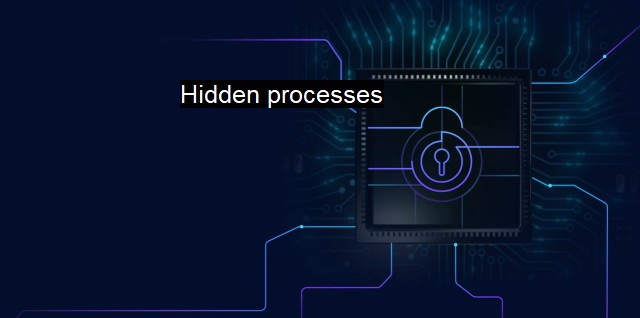What are Hidden processes?
The Threat of Hidden Processes: Navigating the Complexities of Antivirus and Cybersecurity in the Digital Landscape
In the realm of cybersecurity and antivirus software, the term "hidden processes" usually refers to software operations running in the background of a user's system without their awareness or consent. These hidden processes often possess the potential to compromise system functionality, security and user privacy, with some even holding malicious intent.Computers continually run a myriad of processes in tandem; some of these are visible to users, but many remain unseen, running quietly yet vitally in the background. The typical user trusts that their software developers craft these processes to exclusively provide beneficial system operation, but actors with malicious intent often exploit this trust.
A hidden process can be innocuous, necessary for some software to run correctly and efficiently. For instance, a web browser may run hidden processes to manage and restore browser sessions or to support browser extensions. However the concern lies primarily with hidden processes operated by malware — software purposefully designed to cause damage or unauthorized access to a computer system.
Malware-based hidden processes can perform several harmful actions, ranging from monitoring user activity and stealing personal information to altering system settings and allowing unauthorized remote access. Ironically, they can also engage counter-defensive measures to avoid detection and elimination, like mimicking or hiding within legitimate processes, encrypting or mutating their code, and disabling security software.
One familiar type of malware that operates through hidden processes is the Trojan Horse. Similar to its mythological namesake, this malware presents itself as a useful tool or application to deceive users into installing it. Once activated, it silently runs hidden processes that carry out its actual intent. Other malware types like spyware, adware, and some forms of ransomware also run through hidden processes.
Another form of hidden process involves rootkits — malware specifically tailored to enable unauthorized control over a user's system at the most basic or "root" level. Rootkit hidden processes are notoriously dangerous as they can hide at the kernel level, among other system processes, making them challenging to detect and remove even with professional help.
How, then, do we combat these nefarious hidden processes? The answer is by deploying robust and well-maintained cybersecurity tools and practices. Antivirus software serves as the first line of defense against most malicious hidden processes. Using heuristic (behavior-based) and signature-based (known malware definitions) methods, antivirus software can root out and terminate malware before it takes root.
Persistence is also important. Malware developers tirelessly churn out new strains and variants of malicious software, so antivirus software developers must ensure their malware definitions are consistently updated. Other essential security practices include using firewalls, ensuring all software and operating systems are up-to-date, and user education concerning safe digital habits.
In addition to the user's responsibilities, operating system developers and software service providers play a crucial role in combating malicious hidden processes. Tightening security during the software development life cycle, implementing stringent permission systems, and responsiveness towards vulnerabilities aid significantly in reducing the scope for the creation and execution of hidden malware processes.
Although hidden processes can fulfill necessary and helpful functions, their potential for exploitation by malevolent entities remains a significant concern within the spheres of cybersecurity and antivirus management. careful implementation of robust cybersecurity measures and reasonable digital conduct can safeguard users against the threats posed by malicious hidden processes. Uncovering the concealed, in this case, plays a vital role in maintaining a secure and dependable computer system.

Hidden processes FAQs
What are hidden processes?
Hidden processes are processes that are running on a device or system but are not visible to the user. These processes are designed to operate in stealth mode to avoid detection by the user or security software.Why are hidden processes a concern in cybersecurity?
Hidden processes can be used by hackers and malware to carry out malicious activities on a device or system, such as stealing sensitive data or hijacking system resources. They can also be used to circumvent antivirus software, making it more difficult to detect and remove malware.How can hidden processes be detected?
One way to detect hidden processes is to use antivirus software that specifically looks for and identifies hidden processes. Additionally, system administrators can use tools like task manager or process explorer to manually identify any suspicious processes that are running on a device or system.How can I protect my system from hidden processes?
To protect your system from hidden processes, it is important to keep your antivirus software up to date and regularly scan your system for malware. It is also recommended to only download software from reputable sources and avoid suspicious emails or websites that may contain malware. Additionally, keeping your operating system and other software updated with the latest security patches can also help prevent vulnerabilities that could be exploited by hidden processes.| | A | | | B | | | C | | | D | | | E | | | F | | | G | | | H | | | I | | | J | | | K | | | L | | | M | |
| | N | | | O | | | P | | | Q | | | R | | | S | | | T | | | U | | | V | | | W | | | X | | | Y | | | Z | |
| | 1 | | | 2 | | | 3 | | | 4 | | | 7 | | | 8 | | |||||||